The top medical VR motion capture solutions include OptiTrack for high-precision tracking (<0.1s latency), Xsens for wireless rehabilitation assessment, Vicon for sub-millimeter accurate biomechanical analysis, Manus for specialized hand tracking, SenseGlove/Weart for haptic feedback integration, SimX Marketplace for extensive training environments, and AI-enhanced capture systems for adaptive healthcare learning. These technologies offer everything from finger-level precision to real-time gait assessment, transforming medical training and patient care. Discover how these systems are revolutionizing healthcare delivery below.
OptiTrack: High-Precision Tracking for Complex Medical Simulations
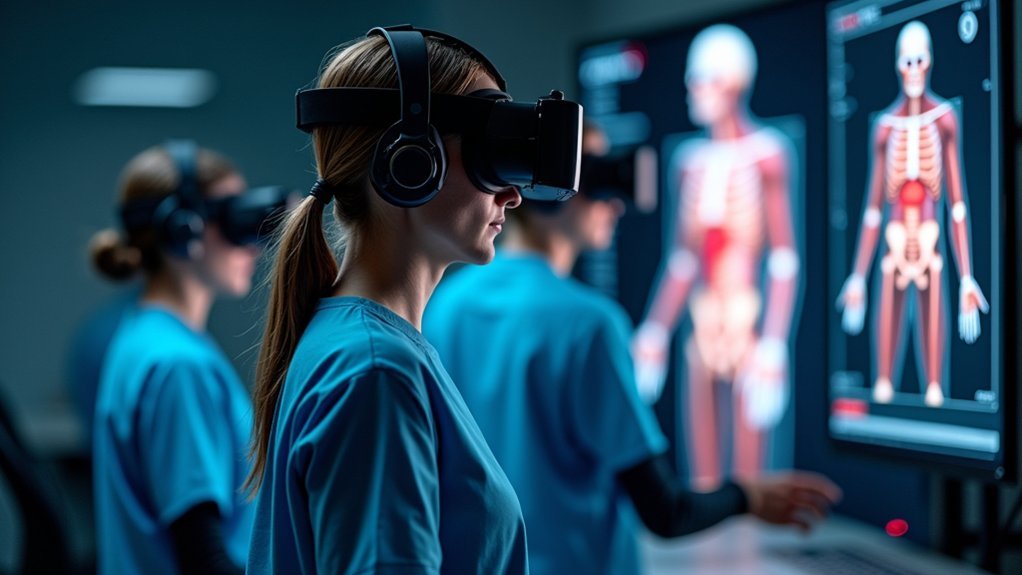
Precision stands at the core of OptiTrack’s industry-leading motion capture technology.
You’ll experience exceptionally low latency (<0.1s) and high accuracy, essential for immersive VR medical environments where real-time feedback matters.
OptiTrack offers flexibility through both passive retroreflective and active Signature Pulse IR markers, tracking multiple subjects simultaneously.
Track multiple subjects concurrently with OptiTrack’s versatile passive retroreflective and active Signature Pulse IR marker options.
This capability proves invaluable for group therapy settings or complex scenario-based medical training.
What sets OptiTrack apart is its seamless integration with force plates and EMG devices, providing thorough biomechanical analysis. The system enables wide area coverage for comprehensive medical simulations in VR CAVEs and head-mounted displays.
The system’s compatibility with Unreal, Unity3D, and other platforms lets you customize solutions for your specific clinical requirements.
For research applications, you’ll benefit from automated event detection and normative data groupsets that streamline comparative studies and intervention outcome evaluations.
Xsens: Wireless Solutions for Rehabilitation and Movement Analysis
When medical professionals require freedom of movement without sacrificing data precision, Xsens delivers an innovative wireless motion capture solution that transforms human movement into detailed digital information.
The system employs 17 wireless sensors attached with adjustable straps, capturing full-body 3D motion from subtle twitches to dynamic movements in real-time.
You’ll appreciate Xsens’ portability and quick setup with no complex calibration requirements.
The MVN Awinda system works reliably even in magnetically challenging environments while providing objective, quantitative movement analysis.
For rehabilitation applications, you can monitor patients during natural activities, create personalized recovery programs, and generate automated reports through MVN Analyze and Reports software.
The technology excels in identifying movement impairments early, facilitating timely intervention and optimizing treatment outcomes.
Vicon: Camera-Based Systems for Detailed Biomechanical Research
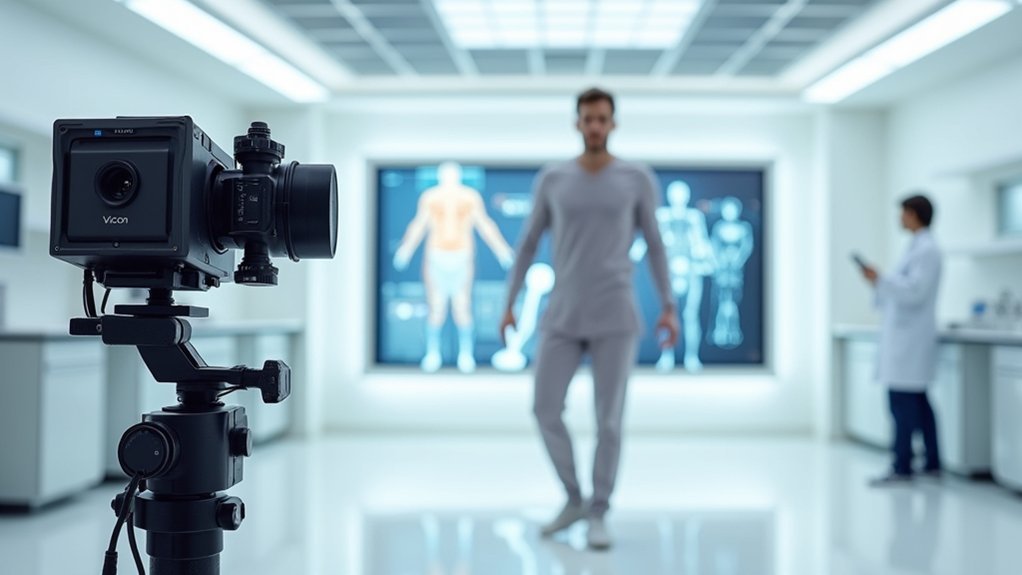
Vicon’s advanced camera systems offer you unmatched clinical precision analytics with sub-millimeter accuracy for thorough biomechanical assessment.
You’ll access real-time gait assessment capabilities that capture joint movements at high sampling rates, enabling immediate feedback during rehabilitation sessions.
Their multi-user research platform accommodates various experimental designs through customizable camera placement and seamless integration with force plates, making it ideal for collaborative clinical studies.
Clinical Precision Analytics
Through decades of refinement, clinical motion capture has evolved into an indispensable tool for biomedical research, with Vicon leading the field in high-precision camera-based analytics.
You’ll benefit from sub-millimeter spatial resolution that captures the finest biomechanical details, essential for clinical decision-making. Vicon Nexus software (version 2.9.3) processes camera data in real-time with low latency, allowing you to make immediate adjustments during experiments.
The system automatically identifies gait parameters, recognizes motion patterns, and analyzes injury mechanisms to inform rehabilitation protocols. For orthopedists and prosthetists, Vicon’s detailed joint dynamics provide critical data for custom device development.
Clinicians can track patient rehabilitation progress using quantifiable metrics, while researchers can customize the software for diverse applications—from human biomechanics to veterinary studies across multiple species.
Real-Time Gait Assessment
At the core of clinical motion analysis, Vicon’s camera-based systems deliver unparalleled gait assessment capabilities with remarkable precision.
With static positioning accuracy of just 0.15 mm and dynamic errors below 2 mm, you’ll capture even the most subtle biomechanical movements.
The Vero 2.2 cameras, operating at up to 120 frames per second, create an extensive spatial network with their 50.1° × 98.1° field of view.
You’re getting immediate feedback on patient movement patterns through Vicon Nexus software, enabling real-time clinical interventions.
This technology extends beyond traditional settings, allowing specialized practitioners like podiatrists and physical therapists to access advanced biomechanical analysis in out-of-lab environments.
You’ll track patient progress, optimize treatment plans, and quantify outcomes with unprecedented detail—all within a streamlined, standardized workflow.
Multi-User Research Platform
Designed for collaborative scientific inquiry, the multi-user research platform transforms how teams conduct biomechanical studies. With Vicon’s user-friendly interface, your research team can work simultaneously on complex movement analyses, viewing real-time data with sub-millimeter precision.
You’ll appreciate the system’s flexibility when tracking joint angles and velocities across different disciplines. Whether you’re studying injury prevention techniques or optimizing athletic performance, the platform enables immediate adjustments during experiments.
The customizable nature of Vicon systems supports diverse research needs, allowing you to integrate force plates and pressure sensors for thorough biomechanical assessment. You can tailor your setup for specific projects while maintaining high-quality data capture with low latency.
This versatility extends to cross-species research, expanding your analytical capabilities beyond human subjects to various animal movement studies.
Manus: Specialized Hand Tracking for Surgical Training Applications
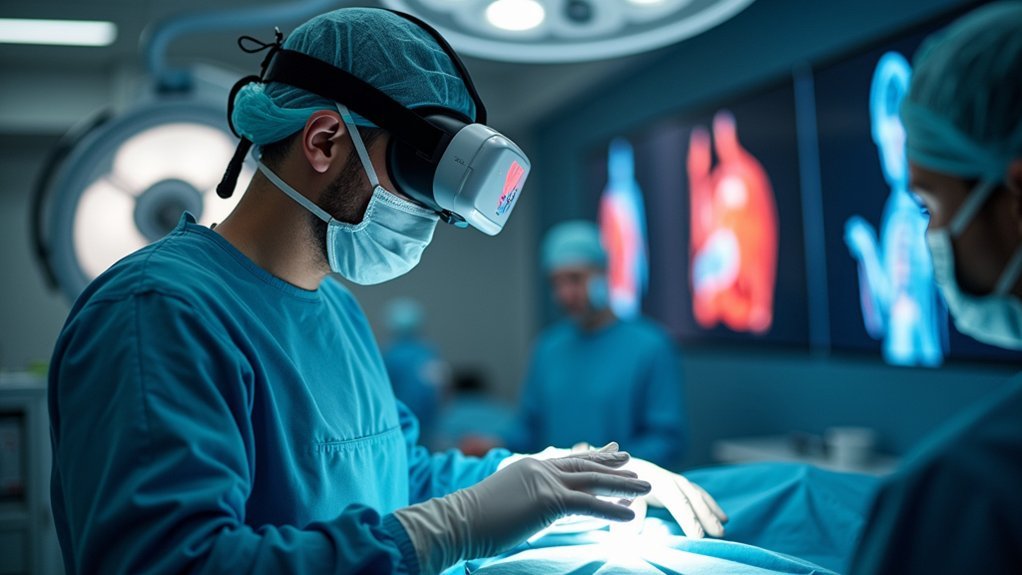
You’ll experience unprecedented finger-level precision with Manus gloves, allowing for natural manipulation of virtual surgical instruments during training procedures.
The system’s haptic feedback creates realistic resistance when you’re handling tissues or operating tools, greatly enhancing surgical simulation realism.
Manus seamlessly integrates with leading VR platforms, enabling you to practice complex procedures in immersive environments that closely mirror real operating room conditions.
Finger-Level Precision Controls
The remarkable precision of Manus VR gloves represents a breakthrough for surgical training simulations, offering finger-level control that mirrors the delicate movements required in real procedures. With nine flex sensors per glove, you’ll experience consistent tracking accuracy that outperforms camera-based solutions.
| Feature | Benefit |
|---|---|
| Individual finger tracking | Enables complex suturing techniques |
| Real-time data processing | Provides immediate response feedback |
| Calibration technology | Minimizes tracking errors |
| Compatible with surgical gloves | Maintains hygiene protocols |
These precision controls allow you to perform intricate manipulations essential for microsurgery training. You’ll develop fine motor skills through natural, gesture-based learning while the system captures nuanced hand dynamics. The gloves’ low-latency performance guarantees your virtual hands respond instantly, critical when practicing delicate procedures requiring millimeter-precise movements.
Haptic Surgical Realism
When surgical realism converges with haptic feedback, Manus VR’s specialized hand tracking transforms medical training experiences.
You’ll benefit from tracking technology that captures 15 joints and 20 motion angles per hand at 120 Hz, providing unparalleled precision for surgical simulations.
The system’s wireless connectivity and modular design minimize setup time, letting you focus on practicing complex procedures.
You’re getting realistic tactile feedback that simulates actual surgical conditions, reinforcing muscle memory through repeatable practice scenarios.
What sets Manus apart is its seamless integration with VR/AR platforms and cross-platform compatibility.
This technology offers cost-effective alternatives to traditional training methods while providing valuable data analysis of hand kinematics.
Your surgical skills will advance through immediate feedback and detailed motion analysis during each simulation.
VR Integration Capabilities
Designed for seamless integration with major VR platforms, Manus VR’s hand tracking system transforms surgical training through extensive cross-platform compatibility.
You’ll benefit from Manus’ advanced SDK that works with systems like Oculus and Vive, supporting both custom and established surgical training platforms like Osso VR. The technology synchronizes with low latency, ensuring realistic hand movements essential for surgical precision.
- Real-time data capture provides immediate feedback for performance assessment
- Markerless tracking reduces setup complexity for extended training sessions
- Compatible APIs allow integration with existing surgical simulation software
- Customizable tracking parameters accommodate specialized surgical procedures
This integration capability means your training program can deploy consistent hand tracking experiences regardless of your institution’s VR hardware preferences, making implementation flexible and future-proof.
SenseGlove and Weart: Haptic Feedback Integration for Medical Procedures
Innovative haptic feedback systems from SenseGlove and Weart are revolutionizing medical VR training by providing realistic touch sensations during simulated procedures.
SenseGlove’s wearable haptic gloves deliver force and tactile feedback that simulate varying resistance and texture, essential for surgical training. You’ll feel differences in softness and solidity while manipulating virtual objects, enhancing realism during procedures like neurosurgical drain placement.
The wireless NOVA model works with standalone VR headsets, offering mobility in clinical environments. These gloves accurately track finger movements, allowing you to practice delicate manipulations without patient risk.
For rehabilitation, these systems help patients recovering from stroke or hand trauma by simulating daily tasks with precise tactile feedback.
You can integrate these haptic solutions to bridge the gap between theoretical knowledge and practical skill development, creating measurable therapeutic interactions.
SimX Marketplace: Comprehensive VR Medical Training Environments
SimX Marketplace stands at the forefront of medical VR training with its extensive library of 250+ pre-built immersive scenarios.
You’ll gain access to thorough specialties from Pediatrics to Critical Care, designed for diverse healthcare roles including nurses, physicians, and EMTs.
The platform’s patented multiplayer technology enables up to four learners to collaborate simultaneously around virtual patients, breaking geographic barriers while enhancing team communication skills. The system offers low-cost implementation of high-fidelity simulation training that integrates seamlessly with existing educational programs.
- Fully wireless VR environment with 425+ simulated medical tools across 474 clinical settings
- Customizable scenarios via intuitive Case Creator, adapting content to your specific needs
- Sandbox mode for risk-free practice before formal training sessions
- Compatible with major VR headsets for flexible deployment in academic or clinical environments
AI-Enhanced Motion Capture for Adaptive Healthcare Learning
Revolutionary AI-driven motion capture technology has transformed rehabilitation by enabling remote monitoring and real-time feedback for patients.
Using just your smartphone or computer camera, you’ll receive immediate guidance on proper positioning and movement quality during therapeutic exercises.
This technology creates a dynamic learning environment where you actively engage with personalized feedback, helping you understand corrections instantly and reinforce proper techniques.
AI-powered chatbots complement this experience by providing clinician-reviewed exercise guidance and educational content.
What makes this approach particularly effective is the system’s adaptability—your exercise recommendations adjust automatically based on your progress and functional capabilities.
This continuous feedback loop between you and your healthcare provider accelerates rehabilitation outcomes while supporting thorough musculoskeletal condition management, whether you’re treating back pain, osteoarthritis, or other MSK conditions.
Frequently Asked Questions
How Long Does It Take to Implement a Medical VR System?
You’ll typically spend 6 months to 2 years implementing a medical VR system. Your timeline depends on factors like system complexity, testing requirements, staff training, and regulatory approvals during the preparation and integration phases.
What Are Typical Maintenance Costs for Motion Capture Equipment?
You’ll typically spend 2-5% of your initial motion capture investment on annual maintenance. This covers hardware servicing, software updates, calibration, and consumables. Plan for larger upgrades ($10,000+) every few years to stay current.
Can These Systems Integrate With Existing Hospital Electronic Health Records?
Yes, you can integrate motion capture systems with your hospital’s EHRs, but you’ll face interoperability challenges, security concerns, and technical compatibility issues. You’ll need specialized expertise and possibly standardized protocols to achieve seamless integration.
How Steep Is the Learning Curve for Medical Staff?
The learning curve for medical staff isn’t steep. You’ll find VR systems equally usable regardless of interaction method. Research shows staff quickly adapt with minimal adjustment period, and you’ll experience steady skill improvement through repeated practice.
Are There Regulatory Approvals Needed for Clinical Training Applications?
Yes, you’ll need regulatory approvals if your VR clinical training applications make medical claims. They may require FDA clearance (510(k) in the US) or equivalent international approvals depending on their classification and intended use.
In Summary
You’ve explored the top medical VR motion capture solutions that are transforming healthcare education and practice. From OptiTrack’s precision to AI-enhanced adaptive systems, these technologies offer unprecedented training opportunities. Whether you’re focusing on surgical simulation, rehabilitation assessment, or biomechanical analysis, you’ll find these tools deliver the immersive, tactile experience needed to bridge the gap between theoretical knowledge and practical clinical skills.


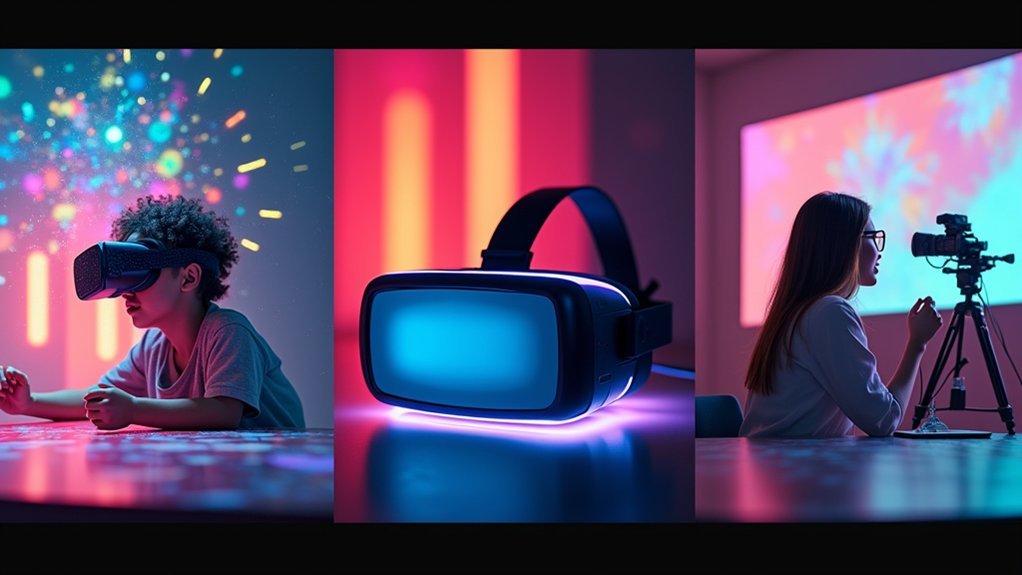
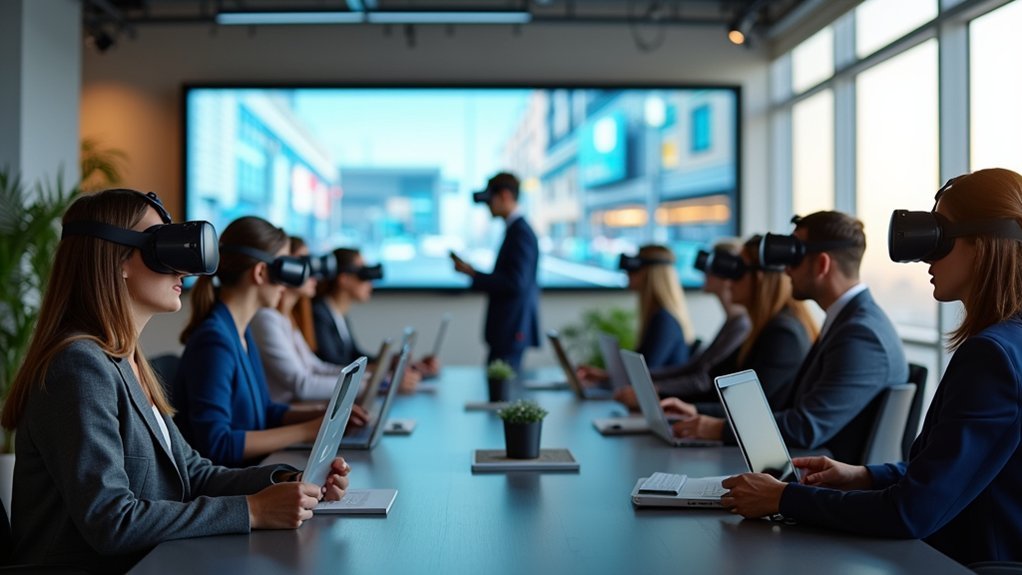

Leave a Reply